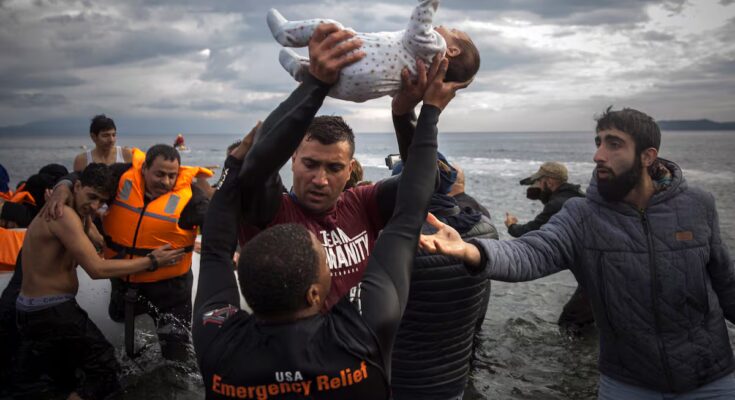In September 2015, the death of three-year-old Syrian boy Aylan Kurdi sparked global horror and outrage. The photograph of his body on a beach in Türkiye made headlines and made visible the plight of those fleeing the war in Syria in search of safety in Europe. That image crystallized a migration crisis involving more than a million people and putting the European Union to the test.
Ten years later, the community club has changed: the growing influence of the far right – already present in one in three European governments – has radicalized positions and tightened migration policies, now focused on the externalization of borders; That is, the EU or its member states pay non-EU countries, often accused of violating human rights, to prevent migrants from reaching European soil.
The result has been a sustained decrease in irregular flows. In 2024, the United Nations High Commissioner for Refugees (UNHCR) recorded 199,400 arrivals. But according to the International Organization for Migration (IOM), screening has also caused more than 36,000 deaths at land and sea borders attempting to enter Europe (more than 32,000 in the Mediterranean alone). The pain of relatives and the invisibility of victims continue to stain the defense of fundamental rights in the EU.
The current European position, criticized by humanitarian organizations and left-wing parties, is defended by Brussels as a way to put an end to the mafias and “regain control” of its borders. “Preserving the balance between solidarity and responsibility is the key to our success,” said the European Commissioner for Migration, Magnus Brunner, last Monday.
That 2015 Aylan was not traveling alone. Like him, according to United Nations data, more than a million people – mainly from Syria, Afghanistan and Iraq – arrived in Europe irregularly and another 3,500 drowned along the way. Some countries reacted with gestures of solidarity – Angela Merkel’s Germany committed to welcoming one million asylum seekers in the following years – but the pressure on external borders and the lack of consensus revealed the first rifts.
In November 2015, the Valletta (Malta) summit between European and African leaders marked the beginning of change: the EU began to look outwards to manage migration and outline its protection policy. According to Jérôme Tubiana, consultant for Doctors Without Borders (MSF), Europe could not apply its policies by respecting its own rules: “It became a task to find the places where the rules could be distorted,” argues the author of the recent report. Strength in the sand: EU externalization policies and trans-Saharan migration routes.
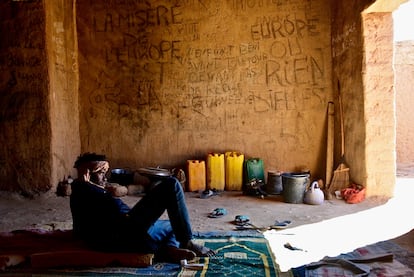
In 2015, the Twenty-Seven pledged to relocate 160,000 asylum seekers over two years to provide relief to Mediterranean states, but the deal failed. Hungary, the Czech Republic and Poland refused, while the others accepted only a small percentage: Spain, for example, accepted only 16% of the 17,000 expected. That failed attempt was the seed of the current Pact on Migration and Asylum, approved in 2024, whose pillars are more controlled border management, faster asylum procedures, “mandatory but flexible” solidarity and cooperation with third countries.
The turning point came on March 18, 2016, with what some call the “deal of shame”: the EU committed to paying 6 billion euros to Turkey to stop irregular immigration. That alliance has created open-air prisons in that country and on the Greek islands with thousands of asylum seekers trapped in undignified conditions, as reported by MSF, Amnesty International and the United Nations, among others.
Although it seemed new, the model was not: Spain had already experimented with it with Morocco. In time, European borders will no longer begin in Lesbos or Lampedusa, but in Libya, Niger, Mauritania or Tunisia. For Commissioner Brunner, these reforms are necessary in the face of “growing frustration” and the “feeling” that European standards “are being ignored”. “We must restore trust, both between member states and EU citizens,” he added, stressing, however, that human rights are “non-negotiable”.
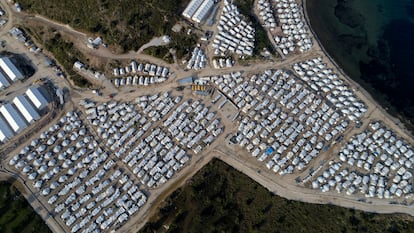
Grainne O’Hara, UNHCR representative in Spain, acknowledges his concern: “There is nothing illegal in looking for solutions outside Europe, but it must be done with transparency and without transferring responsibility to the countries that already host the majority of refugees.” It also describes human rights violations in countries of origin and transit as “unacceptable”.
That 2016, the Balkan route was closed – which crossed Hungary, Albania, Bosnia, Macedonia and Serbia – drastically reducing arrivals in the EU: from one million in 2015 to 185,000 in 2017. But it was not a humanitarian success: more than 12,000 people died at European borders in those three years.
After the pact with Turkey, the EU strengthened its migration control architecture. In 2016 it created Frontex, the European border control agency, which had a budget of 922 million euros in 2024 and faced reports of human rights violations, such as hot returns and the use of violence, which led to the resignation of the previous executive director, Fabrice Leggeri. The Africa Emergency Trust Fund (EUTF) was also launched, in theory to combat the causes of migration – poverty or insecurity – although, according to MEP Estrella Galán (of the left group in the European Parliament), in reality the EU “conditions cooperation on border control”.
The external dimension of migration policy has been consolidated with agreements with third countries. The EU and Italy have signed several pacts with Libya, despite the African country being classified as “unsafe” by the UN due to cases of torture and abuse of migrants. Brussels has allocated more than 700 million euros since 2015 to “migration management”, while Italy has invested around 150 million between 2017 and 2022, according to Oxfam. This agreement was renewed on November 2 for another three years. “Libya is a black hole,” says Tubiana. “Europe says it is monitoring the situation and that the reports are secret for security reasons.” According to the IOM, at least 166,000 migrants have been intercepted by the coast guard in the Mediterranean this decade and returned to Libya.
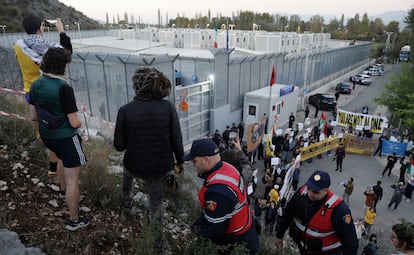
Between 2015 and 2021 the EU also allocated more than 400 million euros to Morocco and Mauritania, and in 2023 it signed a memorandum with Tunisia for another 105 million. Egypt was the last to sign, in the amount of 200 million euros. However, the lack of transparency makes it impossible to know how much money is being spent and where to stop departures to Europe.
Despite efforts, outsourcing departure control did not solve the problem, it only displaced it. “The EU blocks are like having a jug of water full of holes and trying to cover them: when they cover one, the water flows through another. Migrants adapt, but the new routes are more dangerous,” warns Tubiana. While the Libyan Coast Guard increased interceptions from 12% to 50% between 2017 and 2019, the mortality rate at sea increased from 2% to 7%, according to MSF, which for the organization contradicts the European narrative that its policies save lives.
The tightening has also led to human rights violations in several African countries that receive EU funding, as recently revealed by an investigation by EL PAÍS, and to a growing criminalization of NGOs that help migrants in shipwrecks, persecuted by national and European laws.
An expulsion machine
The 2020 pandemic temporarily reduced arrivals, but the Twenty-Seven took advantage of that period to advance the Compact on Migration and Asylum, which will come into force in 2026. This set of ten regulations seeks a unified response to migration challenges. The president of the European Commission, Ursula von der Leyen, defended it as an effective tool to “decide who arrives and under what circumstances”, with faster asylum procedures and a strengthened fight against trafficking networks.
For Galán, however, the pact “led to an expulsion mechanism without guarantees, without legal or safe means, and without putting the person at the centre”. O’Hara recognizes some positive aspects: “It seeks to speed up the identification of protection needs and shorten resolution times. It is positive, as long as human rights are guaranteed.”
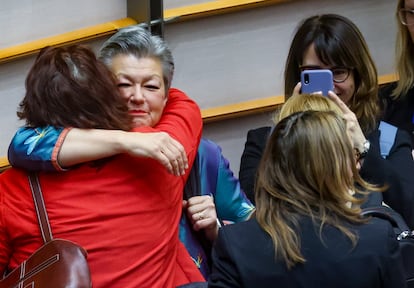
The new framework confirms that the outsourcing of border control has gone from a widespread practice to the central axis of European migration policy. Brussels is moving towards this model and Italy has once again been its laboratory since Giorgia Meloni’s government signed with Albania the creation of a detention center for asylum seekers. “The Italian courts have paralyzed it, but in Brussels it is seen as an innovative model,” warns Galán. “The EU encourages countries to explore new formulas, and we know what this means.”
Others have already tried it. Denmark and the United Kingdom wanted to send asylum seekers to Rwanda, but the justice system prevented them. Recently, London and Paris agreed that France would accept returns from the Channel beaches in exchange for the UK admitting migrants with family links.
According to diplomatic sources, during an informal meeting of justice and interior ministers in Copenhagen in July, humanitarian agencies such as UNHCR were invited to analyze the legal framework of these models. Experts assured that these “innovative solutions” are “totally legitimate” and have a solid legal basis.
Europe also showed solidarity, particularly with Russia’s invasion of Ukraine in 2022, when it first activated the Temporary Protection Directive and welcomed four million Ukrainians. “It could have been done in 2016, but it wasn’t done,” says Galán. For Tubiana the difference lies in the origin of the migrants: “The Ukrainians are white Christians; the Sudanese or black Muslims… Another story”.
According to Frontex data, between January and November 2025, more than 152,000 people arrived irregularly in the EU, the majority by sea, 22% fewer than in the same period in 2024. Just over a thousand deaths were also recorded. These are figures that may seem like a success, but which, according to Tubiana, “in the long term will generate new crises in the countries of origin and transit, causing new displacements”.
